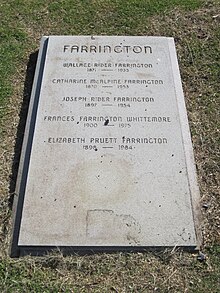Joseph Rider Farrington (October 15, 1897 – June 19, 1954) was an American newspaper editor and statesman who served in the United States Congress as delegate for the Territory of Hawai'i.
Joseph Rider Farrington | |
|---|---|
 Farrington in 1943 | |
| Delegate to the U.S. House of Representatives from Hawaii Territory's At-large district | |
| In office January 3, 1943 – June 19, 1954 | |
| Preceded by | Samuel W. King |
| Succeeded by | Elizabeth P. Farrington |
| Member of the Hawaii Territorial Senate | |
| In office 1934–1942 | |
| Personal details | |
| Born | October 15, 1897 Washington, D.C., U.S. |
| Died | June 19, 1954 (aged 56) Washington, D.C., U.S. |
| Political party | Republican |
| Spouse | Elizabeth P. Farrington |
| Military service | |
| Allegiance | United States |
| Branch/service | United States Army |
| Years of service | 1918–1919 |
| Rank | second lieutenant |


Education and military career
editFarrington was born in Washington, D.C., to Wallace Rider Farrington, the future Territorial Governor of Hawai'i. While still an infant, he moved to Honolulu, Hawai'i with his parents where his father began work as an editor for the Honolulu Advertiser and later the Honolulu Star-Bulletin newspapers. Farrington attended Punahou School and, upon graduating, studied at the University of Wisconsin. He dropped out of college in June 1918 to enlist in the United States Army. He was commissioned a second lieutenant of field artillery in September 1918 and discharged the following December. He returned to the University of Wisconsin–Madison and graduated in 1919.[1]
Newspaper career
editAs soon as he obtained his degree in Wisconsin, Farrington became a reporter on the staff of the Public Ledger in Philadelphia. He served three years as a member of its Washington bureau.[2] He then returned to Honolulu to follow in his father's footsteps and entered the newspaper business. He became a reporter and then editor of the Honolulu Star-Bulletin. In 1939, Farrington succeeded his father to become president and general manager of the Honolulu Star-Bulletin, an office in which he served until his death.[3]
Political career
editFarrington began a part-time political career as secretary to the Hawai'i Legislative Commission in 1933. The following year he was elected to the Hawaii Territorial Senate, an office he served in through 1942. On January 3, 1943, Farrington was sworn in as a Republican delegate to Congress. Farrington was a supporter of Hawaiian statehood and help advise the early post-war efforts for admission.[4]: 121 He died in office in Washington, D.C., on June 19, 1954, of an apparent heart attack.[5] His wife, Elizabeth P. Farrington, was elected to replace him in Congress.[6] Farrington was buried in the Oahu Cemetery in Nuʻuanu Valley in Honolulu.
See also
editReferences
edit- ^ "Biography of the United States Congress". Retrieved December 9, 2011.
- ^ United States Congress (1943). Official Congressional Directory, 78th Congress, 1st Session. Washington, D.C.: United States Government Printing Office.
- ^ Nakaso, Dan (August 16, 2009). "Joseph Farrington". the.honoluluadvertiser.com. Retrieved 2019-08-18.
- ^ Roger Bell (1984). "5 - Issues Confused, 1946-1950: Civil Rights, Party Politics and Communism". Last Among Equals: Hawaiian Statehood and American Politics. Honolulu: University of Hawaii Press. pp. 120–179.
- ^ Hawaiian Delegate to Congress Dies of Heart Attack; The Ada Evening News; Page 13; June 20, 1954
- ^ US House of Representatives website, Farrington, Mary Elizabeth
External links
edit- Joseph Rider Farrington Congressional Papers collection
- A film clip "Longines Chronoscope with Joseph R Farrington" is available for viewing at the Internet Archive
- A film clip "Longines Chronoscope with Joseph R Farrington" is available for viewing at the Internet Archive
- A film clip "Longines Chronoscope with Delegate-to-Congress Joseph R Farrington (June 13, 1952)" is available for viewing at the Internet Archive